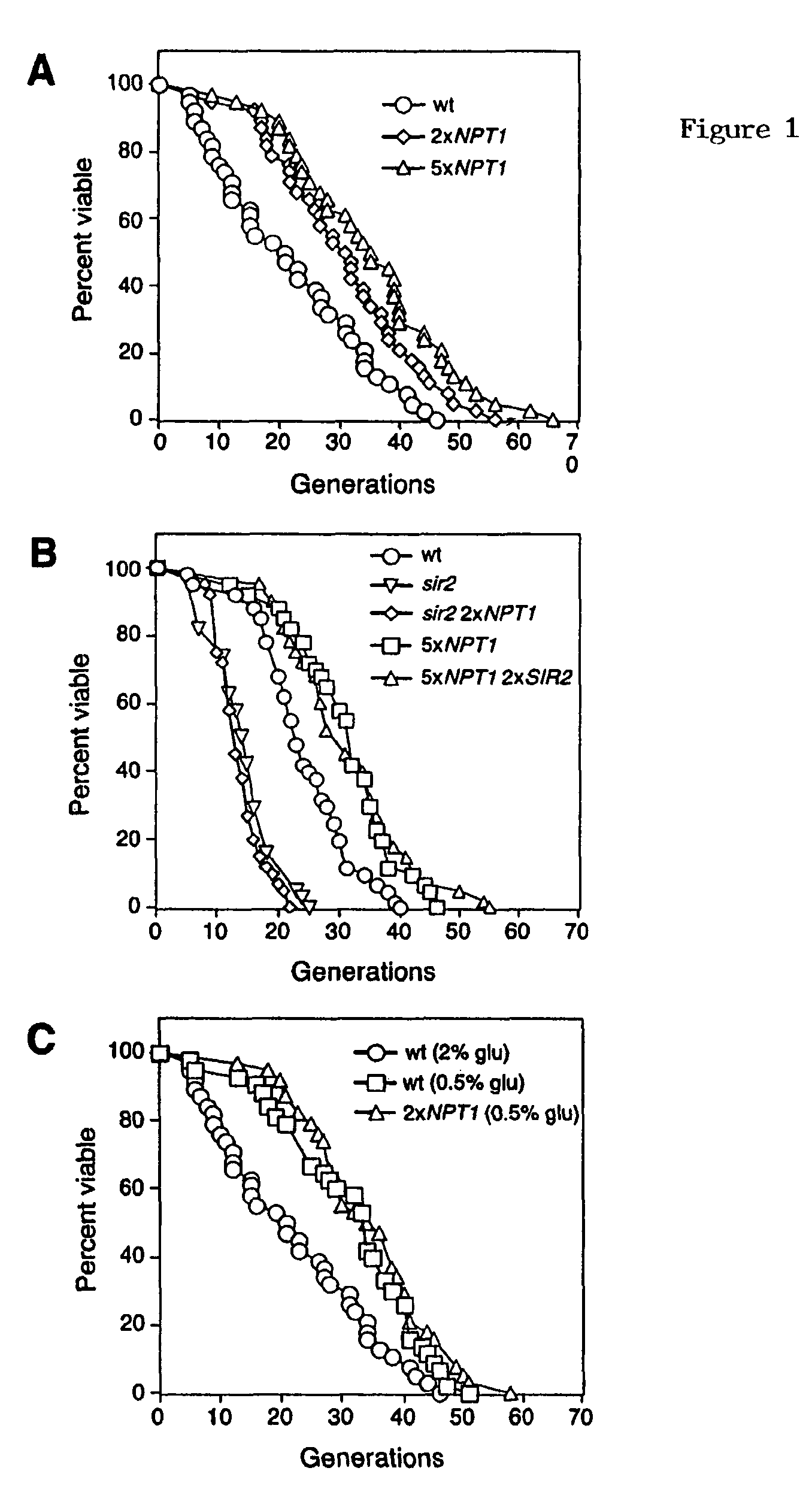Methods and compositions for extending the life span and increasing the stress resistance of cells and organisms
a cell and stress resistance technology, applied in the direction of chemical cell growth stimulation, microorganism preservation, peptide/protein ingredients, etc., can solve the problems of increasing erc formation, and accelerating the aging process. , to achieve the effect of increasing the cell's stress resistance and increasing the flux through the nad+ salvage pathway
- Summary
- Abstract
- Description
- Claims
- Application Information
AI Technical Summary
Benefits of technology
Problems solved by technology
Method used
Image
Examples
example 1
Manipulation of a Nuclear NAD+ Salvage Pathway Delays Aging
[0315]Yeast deprived of nutrients exhibit a marked life span extension that requires the activity of the NAD+-dependent histone deacetylase, Sir2p. Here we show that increased dosage of NPT1, encoding a nicotinate phosphoribosyltranfserase critical for the NAD+ salvage pathway, increases Sir2-dependent silencing, stabilizes the rDNA locus and extends yeast replicative life span by up to 60%. Both NPT1 and SIR2 provide resistance against heat shock, demonstrating that these genes act in a more general manner to promote cell survival. We show that Npt1 and a previously uncharacterized salvage pathway enzyme, Nma2, are both concentrated in the nucleus, indicating that a significant amount of NAD+ is regenerated in this organelle. Additional copies of the salvage pathway genes, PNC1, NMA1 and NMA2 increase telomeric and rDNA silencing, implying that multiple steps affect the rate of the pathway. Although SIR2-dependent processes...
example 2
Increased Genomic Instability and Accelerated Aging by Nicotinamide
[0414]The Saccharomyces cerevisiae Sir2 protein is an NAD+-dependent histone deacetylase that plays a critical role in transcriptional silencing, genome stability and longevity. A human homologue of Sir2, SIRT1, regulates the activity of the p53 tumor suppressor and inhibits apoptosis. The Sir2 deacetylation reaction generates two products: O-acetyl-ADP-ribose and nicotinamide, a precursor of nicotinic acid and a form of niacin / vitamin B3. We show here that nicotinamide completely abolishes yeast silencing and shortens replicative life span to that of a sir2 mutant. Nicotinamide, but not nicotinic acid, strongly inhibits silencing at the telomeres, rDNA and mating type loci of yeast. Nicotinamide also increases instability of the rDNA locus and shortens yeast life span to that of a sir2 mutant. Nicotinamide also abolishes silencing in G1-arrested cells, demonstrating that continual Sir2 activity is required to mainta...
example 3
Nicotinamide, but Not Nicotinic Acid, Bind to the C Pocket of Sir2
[0513]The nicotinamide was docked in the crystal structure of Sir2 from Archaeoglobus fulgidus (Sir2-Af1) bound to NAD+ (Protein Data Bank ID code 1ICI, Min et al. (2001). Crystal structure of a SIR2 homolog-NAD complex. Cell 105, 269-279). It was first manually docked in the C site of Sir2-Af1 using QUANTA (MSI, Inc.). Subsequently, an energy minimization calculation was done with CHARMM (Brooks et al. (1983) J. Comput. Chem. 4, 187-217) with harmonic constraint on Sir2-Af1 and NAD+ (F=2.4 Kcal / mol Å2). FIG. 14A-C were made with PYMOL (DeLano, W. L. The PyMOL Molecular Graphics System (2002) DeLano Scientific, San Carlos, Calif., USA).
[0514]These studies indicate that nicotinamide inhibits Sir2 (see FIGS. 14 A-C) and that nicotinic acid does not inhibit Sir2 because the presence of residue D101 (i.e., acidic) prevents nicotinic acid to dock into the C pocket of Sir2.
PUM
| Property | Measurement | Unit |
|---|---|---|
| real time RT- | aaaaa | aaaaa |
| concentration | aaaaa | aaaaa |
| concentration | aaaaa | aaaaa |
Abstract
Description
Claims
Application Information
 Login to View More
Login to View More - R&D
- Intellectual Property
- Life Sciences
- Materials
- Tech Scout
- Unparalleled Data Quality
- Higher Quality Content
- 60% Fewer Hallucinations
Browse by: Latest US Patents, China's latest patents, Technical Efficacy Thesaurus, Application Domain, Technology Topic, Popular Technical Reports.
© 2025 PatSnap. All rights reserved.Legal|Privacy policy|Modern Slavery Act Transparency Statement|Sitemap|About US| Contact US: help@patsnap.com



